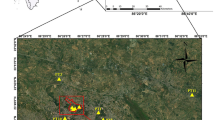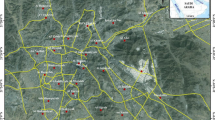Abstract
Guwahati, the Gateway of India in the northeast, is a large business and development center. Past seismic scenarios suggest moderate to significant effects of regional earthquakes (EQs) in Guwahati in terms of liquefaction as well as building damages. Considering the role of local soil in amplifying EQ-generated ground motions and controlling surface damages, present study attempts seismic site classification of subsoil of Guwahati. Subsoil is explored based on 43 geophysical tests and 244 borelogs gathered from different resources. Based on the borehole data, 4 numbers of 2D cross-sections are developed from different parts of Guwahati, clearly indicating that a majority of the locations are composed of clay of intermediate to high plasticity while at specific locations only, layers of sand are found at selective depths. Further, seismic site classification based on 30 m average SPT-N suggests that a major part of Guwahati falls under seismic site class (SSC) D such as Balaji Temple and Airport. However, Assam Zoo, Pan Bazaar, IIT campus, Dhol Gobinda and Maligaon show SSC E clearly indicating the presence of soft soil deposits at these locations. Similar site classification is also attempted from MASW test-based 30 m average shear wave velocity (VS30). VS30-based site classification also categorizes most of Guwahati under SSC D. However, there are locations in the southern part of Guwahati which belong to SSC C as well. Mismatch in SSC based on two different test findings for Indian soil found here are consistent with previous studies. Further, three empirical correlations based on both SPT-N and VS profiles at 22 test locations are developed for: (1) clayey; (2) sandy and (3) all soil types. Proposed correlation for all soil types is validated graphically and is found closely matching with similar correlations for Turkey and Lucknow.












Similar content being viewed by others
References
Anbazhagan, P., Kumar, A., & Sitharam, T. (2010). Site response of Deep soil sites in Indo-Gangetic plain for different historic earthquakes. In Proceedings of the 5th international conference on recent advances in geotechnical earthquake engineering and soil dynamics (Vol. 3). San Diego, California.
Anbazhagan, P., Kumar, A., & Sitharam, T. (2011). Amplification factor from intensity map and site response analysis for the soil sites during 1999 Chamoli earthquake. In Proceedings of the 3rd Indian young geotechnical engineers conference (pp. 311–316). New Delhi.
Anbazhagan, P., Kumar, A., & Sitharam, T. (2013). Seismic site classification and correlation between standard penetration test N value and shear wave velocity for Lucknow City in Indo-Gangetic Basin. Pure and Applied Geophysics, 170(3), 299–318.
Anbazhagan, P., & Sitharam, T. (2008). Site characterization and site response studies using shear wave velocity. Journal of Seismology and Earthquake Engineering, 10(2), 53.
Athanasopoulos, G. A. (1995). Empirical correlation Vs-N SPT for soils of Greece; a comparative study of reliability study of reliability. In Proceedings of the 7th international conference on soil dynamics earthquake engineering (Chania, Crete) A S Cakmak (pp. 19–36). Southampton: Computation Mechanics.
Ayothiraman, R., Kanth, S. R., & Sreelatha, S. (2012). Evaluation of liquefaction potential of Guwahati: Gateway city to Northeastern India. Natural Hazards, 63(2), 449–460.
Baro, O., & Kumar, A. (2015). A review on the tectonic setting and seismic activity of the Shillong Plateau in the light of past studies. Disaster Advances, 8(7), 34–45.
Baro, O., & Kumar, A. (2017). Seismic source characterization for the Shillong Plateau in Northeast India. Journal of Seismology, 21(5), 1229–1249.
Bilham, R., & England, P. (2001). Plateau’pop-up’in the great 1897 Assam earthquake. Nature, 410(6830), 806.
Boore, D. M. (2004). Estimating Vs(30) (or NEHRP site classes) from shallow velocity models (depths < 30 m). Bulletin of the Seismological Society of America, 94(2), 591–597.
BSSC. (2003). NEHRP recommended provision for seismic regulation for new buildings and other structures (FEMA 450). Part 1: Provisions, Building Safety seismic council for the federal Emergency Management Agency, 2003, Washington D. C., USA.
CNDM. (2002). Scenario of seismic hazard in Assam, report by Centre for Natural Disaster Management, Assam Administrative Staff Office. Retrieved September 16, 2014, from http://aasc.nic.in/course%20material/Disaster/SCENARIO%20OF%20SEISMIC%20HAZARD%20IN%20ASSAM.pdf.
Dikmen, Ü. (2009). Statistical correlations of shear wave velocity and penetration resistance for soils. Journal of Geophysics and Engineering, 6(1), 61.
Everett, M. E. (2013). Near-surface applied geophysics. Cambridge: Cambridge University Press.
Fujiwara, T. (1972). Estimation of ground movements in actual destructive earthquakes. In Proceedings of the fourth European symposium on earthquake engineering (pp. 125–132). London.
GSI. (2000). Seismotectonic atlas of India and its environs. Bangalore, India: Geological Survey.
Hanumantharao, C., & Ramana, G. (2008). Dynamic soil properties for microzonation of Delhi, India. Journal of Earth System Science, 117(2), 719–730.
Hasancebi, N., & Ulusay, R. (2007). Empirical correlations between shear wave velocity and penetration resistance for ground shaking assessments. Bulletin of Engineering Geology and the Environment, 66(2), 203–213.
Imai, T. (1977). P and S wave velocities of the ground in Japan. In Proceedings of the 9th International Conference on Soil Mechanics and Foundation Engineering (Vol. 2, pp. 257–260).
Imai, T. (1982). Correlation of N value with S-wave velocity and shear modulus. In Proceedings of the second European symposium on penetration testing (pp. 67–72).
Imai, T., & Yoshimura, Y. (1970). The relation of mechanical properties of soils to P and S wave velocities for ground in Japan, Technical note, OYO Corporation.
Imai, T., Fumoto, H., Yokota, K. (1975). The relation of machanical properties of soil to P and S wave velocities in Japan, Proceedings of 4th Japan Earthquake Engineering Symposium (in Japanese). pp. 89–96.
IS. 1893 (2002). Indian standard criteria for earthquake resistant design of structures, Part 1—general provisions and buildings. New Delhi: Bureau of Indian Standards.
Iyisan, R. (1996). Correlations between shear wave velocity and in situ penetration test results. Technical Journal Chamber Civil Engineering (in Turkish), 7, 371–374.
Jafari, M., Asghari, A., & Rahmani, I. (1997). Empirical correlation between shear wave velocity (Vs) and SPT-N value for south of Tehran soils. In Proceedings of the 4th international conference on civil engineering. Tehran, Iran.
JRA (Japan Road Association, 1980). Specification for Highway bridges. Part V, Earthquake Resistant design.
Kayal, J. (1998). Seismicity of Northeast India and surroundings: Development over the past 100 years. Journal of Geophysics, 19(1), 9–34.
Kumar, A., Anbazhagan, P., & Sitharam, T. (2012). Site specific ground response study of deep Indo-Gangetic basin using representative regional ground motions. In GeoCongress 2012: State of the art and practice in geotechnical engineering (pp. 1888–1897).
Kumar, A., Anbazhagan, P., & Sitharam, T. (2013). Liquefaction hazard mapping of Lucknow: A part of Indo-Gangetic Basin (IGB). International Journal of Geotechnical Earthquake Engineering (IJGEE), 4(1), 17–41.
Kumar, A., & Baro, O. (2016). In-direct estimation of local soil response in the light of past as well as recent earthquakes in the Shillong Plateau. In Proceeding of the Indian geotechnical conference IIT Madras. Chennai, India.
Kumar, A., Baro, O., & Harinarayan, N. (2016). Obtaining the surface PGA from site response analyses based on globally recorded ground motions and matching with the codal values. Natural Hazards, 81(1), 543–572.
Kumar, A., Baro, O., & Narayan, L. M. (2014). Estimation of surface PGA and determination of target value for no liquefaction at Guwahati city. Proceedings of Geo-Innovations. Bangalore, India: Indian Institute of Science.
Kumar, A., Harinarayan, N. H., & Baro, O. (2015). High amplification factor for low amplitude ground motion: assessment for Delhi. Disaster Advances, 8(12), 1–11.
Kumar, A., Harinarayan, N., & Baro, O. (2017a). Nonlinear soil response to ground motions during different earthquakes in Nepal, to arrive at surface response spectra. Natural Hazards, 87(1), 13–33.
Kumar, A., Harinarayan, N. H., & Baro, O. (2017b). Effects of earthquake motion and overburden thickness on strain behavior of clay and sandy soils. In Proceedings of 16th world conference on earthquake engineering. Santiago, Chile.
Kumar, A., & Mondal, J. K. (2017). Newly developed MATLAB based code for equivalent linear site response analysis. Geotechnical and Geological Engineering, 35, 2303–2325.
Maheswari, R. U., Boominathan, A., & Dodagoudar, G. (2010). Use of surface waves in statistical correlations of shear wave velocity and penetration resistance of Chennai soils. Geotechnical and Geological Engineering, 28(2), 119–137.
Martin, A. J., & Diehl, J. G. (2004) Practical experience using a simplified procedure to measure average shear-wave velocity to a depth of 30 meters (Vs30). In Proceedings of 13th world conference on earthquake engineering. Vancouver, BC, Canada.
Mondal, J. K., & Kumar, A. (2016). Impact of higher frequency content of input motion upon equivalent linear site response analysis for the study area of Delhi. Geotechnical and Geological Engineering, 35(3), 959–981.
NDMA. (2011). Geotechnical/Geophysical Investigation fort Seismic microzonation studies of urban centers in India, Technical report.
Ohba, S., & Toriuma, I. (1970). Research on vibrational characteristics of soil deposits in Osaka, Part 2, on velocities of wave propagation and predominant periods of soil deposits. In Technical Meeting of Architectural Institute of Japan.
Ohsaki, Y., & Iwasaki, R. (1973). On dynamic shear moduli and Poisson’s ratios of soil deposits. Soils and Foundations, 13(4), 61–73.
Ohta, Y., & Goto, N. (1978). Empirical shear wave velocity equations in terms of characteristic soil indexes. Earthquake Engineering and Structural Dynamics, 6(2), 167–187.
Oldham, T. (1882). The Cachar earthquake of 10th January 1869: Geological Survey of India.
Oldham, R. D. (1899). Report of the great earthquake of 12th June, 1897: Office of the Geological survey.
Park, C. B., Miller, R. D., & Xia, J. (1998). Imaging dispersion curves of surface waves on multi-channel record. In SEG Technical Program Expanded Abstracts 1998 (pp. 1377–1380): Society of Exploration Geophysicists.
Press, W. H., Teukolsky, S. A., & Vetterling, W. T. (1992). FlanneryB. P., Numerical Recipes in C. Cambridge University Press.
Raghukanth, S. T. G., & Dash, S. K. (2010). Evaluation of seismic soil-liquefaction at Guwahati city. Environmental Earth Sciences, 61(2), 355–368.
Ryden, N., & Park, C. B. (2006). Fast simulated annealing inversion of surface waves on pavement using phase-velocity spectra. Geophysics, 71(4), R49–R58.
Schwab, F., Knopoff, L., & Bolt, B. (1972). Fast surface wave and free mode computations. Methods in computational physics, 11, 87–180.
Seed, H., & Idriss, I. (1981). Evaluation of liquefaction potential sand deposits based on observation of performance in previous earthquakes. In ASCE National Convention (MO) (pp. 481–544).
Sharma, B., & Rahman, S. K. (2016). Use of GIS based maps for preliminary assessment of subsoil of Guwahati City. Journal of Geoscience and Environment Protection, 4(05), 106.
Xia, J., Miller, R. D., & Park, C. B. (1999). Estimation of near-surface shear-wave velocity by inversion of Rayleigh waves. Geophysics, 64(3), 691–700.
Acknowledgements
Authors would like to thank start-up project titled “Seismic site classification of Guwahati city and development of design response spectra considering detailed in situ geotechnical and geophysical studies” from IIT Guwahati for necessary motivation and financial support for this work. Further, authors ate thankful to Guwahati Metropolitan Development Authority (GMDA) for sharing necessary borehole reports and for permitting MASW tests across Guwahati without which present work would not have been possible.
Author information
Authors and Affiliations
Corresponding author
Electronic supplementary material
Below is the link to the electronic supplementary material.
Rights and permissions
About this article
Cite this article
Kumar, A., Harinarayan, N.H., Verma, V. et al. Seismic Site Classification and Empirical Correlation Between Standard Penetration Test N Value and Shear Wave Velocity for Guwahati Based on Thorough Subsoil Investigation Data. Pure Appl. Geophys. 175, 2721–2738 (2018). https://doi.org/10.1007/s00024-018-1858-1
Received:
Revised:
Accepted:
Published:
Issue Date:
DOI: https://doi.org/10.1007/s00024-018-1858-1




